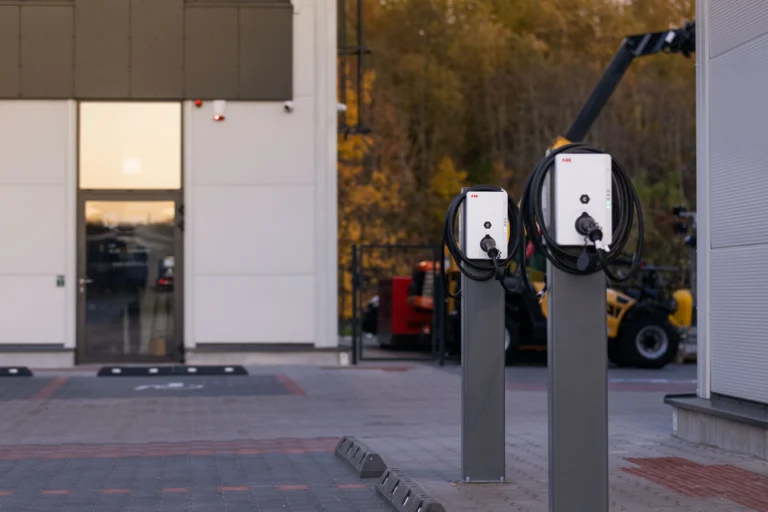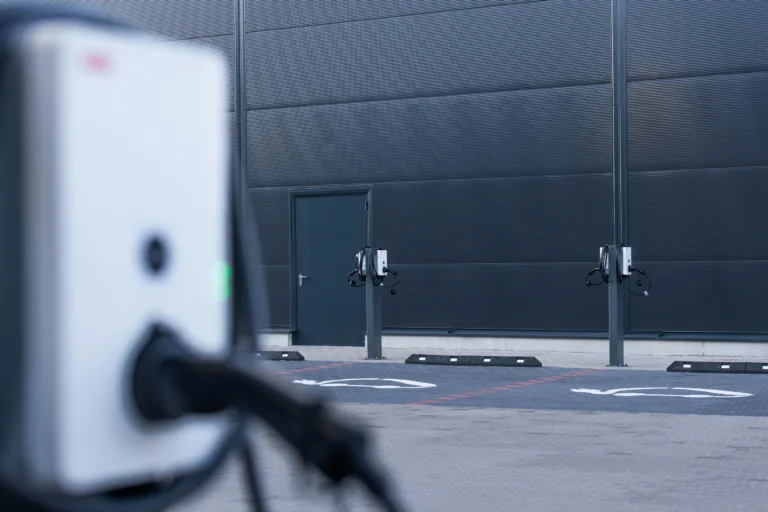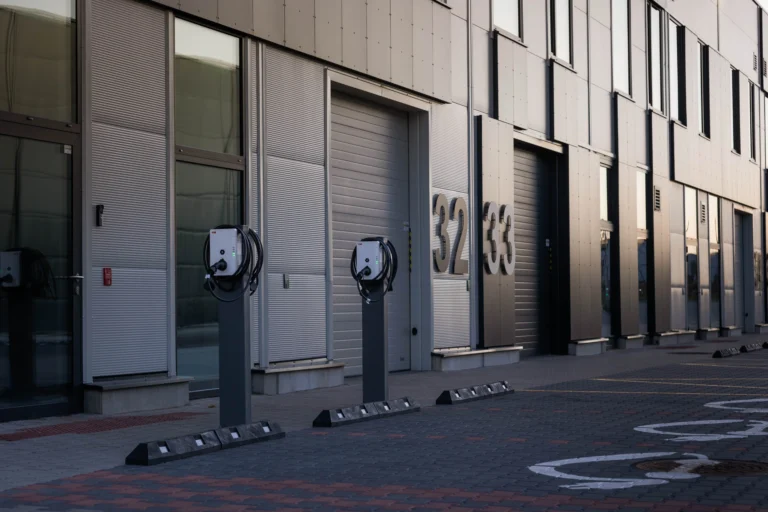On 5 September, the third call for legal entities to benefit from the Lithuanian Energy Agency’s support for the installation of private charging stations for electric vehicles in workplaces started. This time, the support has been increased. Up from 30% previously. This has now risen to 50%. eligible costs. However, you can’t just pick any bus stop and apply for a refund.
“The main requirement for a station is that it must have a dynamic power controller, which must be up and running when installed. It is essential to use specialists to choose the right equipment, because we do encounter customers who install one or two stations to save money, and when they want to increase the number of stations, it becomes impossible because the existing equipment does not support the required protocols and there is no provision for infrastructure expansion. The dynamic power controller allows all stations to be power-balanced, and 10, 20 or 30 units can be installed. 22 kW stations using the available power,” explained Paulius Gūžys, the head of Įkrautas, the company that sells and installs the stations.
Dynamic power controllers protect the electrical input against blown fuses. It also makes better use of existing power lines. Increasing the charging infrastructure will not require the purchase of additional power from ESO and will not require the payment of a capacity charge, but will make use of the available capacity.

The Lithuanian Energy Agency finances the purchase of the equipment, the dynamic power management equipment, the installation works and the grid connection costs. The rate of support for the third phase, which will run from 5 September 2024 to 29 August 2025, will be 50 %. of the eligible costs mentioned above. However, the support is not calculated on the amount proposed by the contractor, but on the amount of the project as set by the Ministry of Energy.
Lietuvos energetikos agentūra verslui finansuoja dalį įkrovos stotelių įsigijimo ir montavimo bei kitų susijusių darbų išlaidų. Trečiojo etapo metu, kuris truks iki 2025 metų rugpjūčio 29 dienos, paramos dydis siekia 50 proc. nuo anksčiau minėtų, finansuoti tinkamų išlaidų. Tiesa, parama yra skaičiuojama ne nuo rangovo pasiūlytos sumos, o nuo patvirtintų fiksuotųjų išlaidų įkainių.
Europos socialinio fondo agentūra, atlikusi rinkos analizę nustatė vidutines įkrovimo stotelių įrengimo kainas pagal stotelės galingumą, montavimo vietą – ar ji montuojama ant sienos, ar ant žemės, su dinaminiu galios valdymu ar be jo, ir patvirtino fiksuotus išlaidų įkainius, taikomus skirtingiems pareiškėjams.

“According to the 2024. 5 September small businesses, public legal entities and medium-sized or large enterprises eligible for minor(de minimis) State aid can apply and receive up to 50% of the total amount of the grant. funding for private charging points for electric cars. For example, a company can receive from €992.97 for each wall-mounted charging access and from €1,661.91 for each ground-mounted access,” said Laura Bogušienė, Senior Project Manager at the LEA’s Project Administration Division.
“In reality, the prices of charging stations with access vary, with one charging station costing €500, another €1,500, and a third €3,600 excluding VAT. And each customer’s site for installing EV charging stations is different. One customer may have to dig a few metres, another a hundred metres. The quantity of cables and other materials, the capacity of the existing inlet, or the need for a new inlet vary. However, it is usually possible to “fit in” with the amounts of support given, the most important thing is to turn to specialists to help find the best solution,” commented the representative of “Įkrautas”.
Dėl paramos įkrovimo infrastruktūrai juridiniams asmenims gali kreiptis visos įmonės, viešosios įstaigos, savivaldybės, NVO, švietimo ir kitos institucijos. Prieš priimdamos sprendimą, įmonės turėtų pasitikrinti Suteiktos valstybės pagalbos ir nereikšmingos (de minimis) pagalbos registre (KOTIS), ar jos turi minėtos pagalbos likutį, ten bus matyti, kokį finansavimą galima gauti. Paraiškos pildomos internetu Lietuvos energetikos agentūros svetainėje www.ena.lt. Taip pat svarbu iš anksto apsvarstyti, kiek įkrovimo stotelių planuojama įrengti.
Trečiajame kvietimų teikti paraiškas etape numatyta viešiesiems ir privatiems juridiniams asmenims paskirstyti kiek daugiau nei 12 mln. eurų.
“Phase 3 support is really working. As soon as the call went out, the number of requests for bus stops from businesses increased by around 40%,” said Paulius Gūžys.
According to the LEA, more than 250 applications were received in the first two months of the third call for support, compared to a total of 255 in the first call and 556 in the second.
The growing network of EV charging facilities in Lithuanian company parking lots shows that the support is effective in achieving the objectives: to reduce overall emissions, to contribute to the development of a sustainable transport system in Lithuania and to promote the development of the country’s EV infrastructure, and to enable residents to charge their EVs at their workplaces.
Having our own charging infrastructure will encourage more and more company employees to switch to clean, electric vehicles. In addition, the ability to charge an electric car at the workplace will motivate an increasing proportion of the population to switch away from combustion engines. In the future, topping up the battery of an electric car will become even easier, as Lithuania aims to install 53,000 EVs by March 2026. private charging stations.

„Pagrindinė priežastis dėl ko paraiškos vertinimo ir mokėjimo prašymo nagrinėjimo terminai gali būti ilgesni nei 55 darbo dienos, tai klaidos paraiškose ir mokėjimo prašymuose“ – pažymėjo Laura Bogušienė.
„Įkrautas“ ekspertai pataria: jeigu jau esate įsirengę įkrovimo stoteles, atitinkančias kvietimo sąlygas, teikdami paraišką kartu pateikite ir mokėjimo prašymą kartu su privalomais dokumentais. Tai gali žymiai sutrumpinti išmokos gavimo laikotarpį.
„Trečiasis kvietimų teikti paraiškas etapas tikrai veikia. Vos paskelbus kvietimą, verslo užklausų kiekis stotelėms įsigyti išaugo apie 40 proc.“, – statistika pasidalino Paulius Gūžys.
LEA duomenimis, įpusėjus trečiajam kvietimų teikti paraiškas etapui, gauta beveik 770 paraiškų, kai per pirmąjį kvietimų etapą iš viso buvo pateikta 191 paraiška, o per antrąjį – 523 paraiškos.
Besiplečiantis elektromobilių įkrovimo stotelių tinklas Lietuvos įmonių stovėjimo aikštelėse rodo, kad parama veiksminga siekiant užsibrėžtų tikslų – mažinti bendrą išmetamų teršalų kiekį, prisidėti prie tvarios transporto sistemos kūrimo Lietuvoje ir skatinti elektromobilių infrastruktūros plėtrą šalyje bei sudaryti sąlygas gyventojams įkrauti elektromobilius darbovietėse.
Nuosava įkrovimo infrastruktūra paskatins daugiau įmonių darbuotojų pereiti prie netaršaus, elektra varomo transporto. Be to, galimybė įkrauti elektromobilį darbovietėje motyvuos vis didesnę gyventojų dalį atsisakyti vidaus degimo varikliais varomų automobilių. Ateityje elektromobilio baterijos papildymas taps dar paprastesnis, nes Lietuva iki 2026 metų kovo užsibrėžusi labai ambicingą tikslą – įrengti 53 tūkst. privačių įkrovimo prieigų.